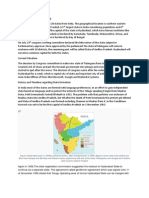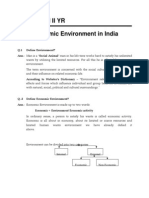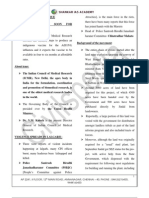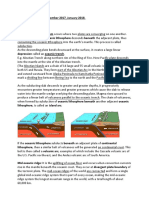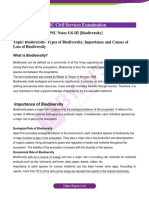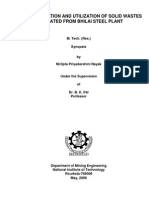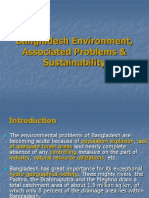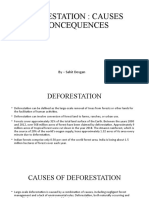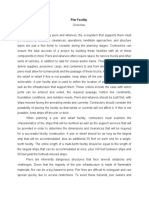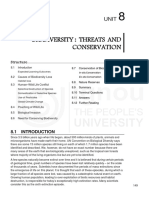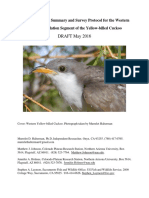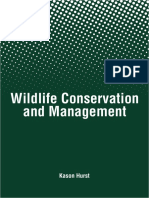Importance of National Parks and Wildlife Sanctuaries in India
Importance of National Parks and Wildlife Sanctuaries in India
Uploaded by
supriyasakatCopyright:
Available Formats
Importance of National Parks and Wildlife Sanctuaries in India
Importance of National Parks and Wildlife Sanctuaries in India
Uploaded by
supriyasakatOriginal Description:
Copyright
Available Formats
Share this document
Read this document in other languages
Did you find this document useful?
Is this content inappropriate?
Copyright:
Available Formats
Importance of National Parks and Wildlife Sanctuaries in India
Importance of National Parks and Wildlife Sanctuaries in India
Uploaded by
supriyasakatCopyright:
Available Formats
Importance Of National Parks And Wildlife Sanctuaries In India
India is a diverse geographical country. It contains various different species of flora and fauna. This
diversity is like a heritage for us. It is our responsibility to preserve this rich wildlife. Preservation of this
natural heritage is also necessary for the ecosystem of our earth. It controls on the global warming,
pollution and various other related problems. Due to these reasons, various areas are declared as the
national parks and wildlife sanctuaries in the country for the protection of animals and their natural
habitant.
National Parks and Wildlife Sanctuaries are the protected areas in which human interference are not
allowed. These areas are completely free from the any kind of human renovation. Hunting and other
related activities are also not allowed in these reserves. More than 100 national parks and 550 wildlife
sanctuaries are spread across the country. These destinations are the natural habitant for the rare species
of Indian flora and fauna. Royal Indian Tigers are the most protected species from all the Indian animals.
Approximately 40 areas are declared as the tiger reserves in India for the protection of royal tigers in
Project Tiger program. These tiger reserves cover approximately 37,760 sq-km area of the country.
Project Tiger is a wildlife conservation program administrated by National Tiger Conservation Authority
in India since 1973. Project Tiger program is specially start for the protection of Bengal Tigers in India.
This program finds out the reasons behind the declining population of tigers and tries to eliminate those
factors to maximize their population. The main purpose behind this program is to protect and maintain the
population of Bengal tigers in their natural habitant. It helps to increase their population and also save
them from hunting and killing.
There are various other national parks for Wildlife Conservation In India which preserve other verities
of Indian animals. Like Kaziranga National Park famous for famous preserving the One-Horned Rhino in
the country. Bharatpur Bird Sanctuary is the natural habitant of more than 300 specious of birds. It is one
of the finest bird sanctuaries in the world. Periyar wildlife sanctuary of Kerala is also a very famous
reserve in India. It is the habitant of more than one thousand elephants.
These are the some areas for wildlife protection in India. Among all of them, Jim Corbett National Park
India is the oldest protected area in India. This park was established in 1936 by the ecologist Jim Corbett.
Now this park is located in the foothills of Himalayan in state Uttarakhand. This park is also declared as
the tiger reserve and preserves the royal Bengal Tigers of India.
These destinations are not only preserving the rich wildlife of the country but also become as one of the
major attractions of India tourism. Nature lovers come from all around the world to spend their vacation
and enjoying these diverse geographical destinations of the country.
Literature
K K Gurung & Raj Singh: Field Guide to the Mammals of the Indian Subcontinent, Academic Press,
San Diego, ISBN 0-12-309350-3
William Riley, laura Riley: Nature's Strongholds. The World's Great Wildlife Reserves. Princeton
University Press, 2005. ISBN 0-691-12219-9
http://www.ecoinfoindia.org/lldb_rajivgandhi_np.php
Kazmierczak, K. 2000. A field guide to the birds of India, Sri Lanka, Pakistan, Nepal, Bhutan,
Bangladesh and the Maldives. OM Book Service, New Delhi, India. 352 pp.
Menon, V. 2003. A field guide to Indian mammals. DK (India) Pvt Ltd and Penguin Book India (P)
Ltd. 201 pp.
Why are protected areas important?
Conservation
Conservation of biodiversity (the variety of our native species and the ecosystems they form) is the
central purpose of protected areas. High levels of biodiversity keep ecosystems healthy and resilient,
which means that they continue providing vital ecosystem services such as nutrient cycling, climate
regulation, air and water purification and pollination. Protecting biodiversity is vital to safeguard our
economy; our cultural, spiritual and aesthetic values; and the intrinsic value of species and ecosystems.
Unfortunately, the biodiversity of NSW is in steep decline, with nearly 1000 species of plants and animals
listed as threatened, 76 of which are believed to be extinct. More than half of all mammal species in NSW
are threatened. There are many pressures on native species and ecosystems, including land clearing for
agriculture, mining and urban expansion, overexploitation (e.g. through too much logging or fishing),
invasive species and diseases, and climate change.
Our system of national parks and other protected areas is the cornerstone of conservation in NSW. They
are vital for the stabilisation and recovery of threatened species. National parks and other reserves provide
a backbone of core conservation areas in NSW, which can then be linked by conservation efforts on all
land tenures across the landscape.
Climate change
Climate change poses a major threat to Australia's ecosystems and the natural resources upon which our
flora and fauna depend. It is already causing changes to our environment such as rising sea levels, ocean
acidification, altered rain and temperature patterns and extreme weather events.
The effects of climate change exacerbate existing problems, such as habitat loss, increasing frequency and
intensity of bushfires, changes to water distribution and quality and pressure from conflicting land uses.
CSIRO studies in 2008 and 2012 conclude that a well managed and carefully planned network of
protected areas will help to buffer the effects of climate change on the NSW landscape and minimise the
loss of biodiversity. Climate change will cause shifts in the distribution of species and ecosystems within
individual reserves, and management of protected areas and landscapes will need to be adapted over time.
Nonetheless, the studies concluded that creating a reserve system that is as extensive, widespread and
diverse as possible will give our unique wildlife and ecosystems the greatest chance of survival,
particularly in conjunction with connectivity conservation initiatives that integrate on-park and off-park
conservation.
Culture and Heritage
NSW national parks and other reserves protect a wide range of Aboriginal heritage places and artefacts,
and restore or provide access to places and resources for cultural and spiritual practices. A number of
national parks are jointly managed, or co-managed, by the government and local Aboriginal people.
There are also a number of Indigenous Protected Areas in NSW.
NSW protected areas also preserve other aspects of culture and heritage, including historic rural buildings
and sites, and unique geological heritage features such as cave systems.
Public enjoyment and access
Critics of national parks and protected areas sometimes claim that national parks are locked up land.
However, the opposite is true: our national park system allows the public to access and enjoy many of the
diverse and spectacular natural areas of NSW, whilst also protecting them for future generations to enjoy.
They also provide places for education and scientific study.
Public ownership of the protected area system ensures that there is ongoing professional management that
is publicly accountable and supported by financial investment from the government; public participation
in management planning; and public access to most areas with visitor facilities provided in many
locations.
Economic and social values
Intact natural areas provide a variety of resources and processes that benefit human society. These are
known as 'ecosystem services'.
For example, many protected areas provide a water catchment and filtration service, which is important
for urban use, agriculture and industry, as well as for native species and ecological processes. Natural
areas also play an important role in improving air quality.
Undisturbed natural forests are also vital resources because they store large amounts of carbon in their
soils and wood. Deforestation and degradation of native forests are major sources of greenhouse gas
emissions.
Protected areas help to preserve the genetic diversity of the species within them. This increases the
opportunity for scientific discoveries of new biological chemicals, which may be important for medicine
or industry. Protecting genetic diversity within protected areas also helps to make them more resilient to
threats such as disease and climate change.
Regional areas benefit from the creation of jobs in tourism, park management and capital works, as well
as from the money spent on accommodation, fuel and food in local towns by park visitors. There were
around 38 million visits to NSW parks in 2010. The Office of Environment and Heritage provides some
examples of the economic benefits of national parks. For example, Sturt National Park receives around
35,000 visitors each year, has generated 97 jobs in management and visitor-related roles, and has
contributed approximately $3.2 million to the economy.
In addition to economic benefits, national parks and reserves also have a range of social benefits for both
residents and visitors to NSW, by providing locations for passive, environmentally sensitive recreation
and allowing people to connect with nature and our cultural heritage.
You might also like
- Fish and Fisheries in Estuaries: A Global PerspectiveDocument1,102 pagesFish and Fisheries in Estuaries: A Global PerspectiveCarlos BlasNo ratings yet
- Monuments of National ImportanceDocument3 pagesMonuments of National ImportanceRashmi Kalden0% (1)
- Bifurcation of Andhra PradeshDocument1 pageBifurcation of Andhra PradeshSrinivasaRaoGorti0% (1)
- Andhra Pradesh Split in India PDFDocument3 pagesAndhra Pradesh Split in India PDFAkshay KarandeNo ratings yet
- Forests of Andhra PradeshDocument399 pagesForests of Andhra PradeshRSNo ratings yet
- Culture of Andhra Pradesh WekipediaDocument9 pagesCulture of Andhra Pradesh WekipediaDattatreyaNo ratings yet
- Sample Udc CPT (2012)Document12 pagesSample Udc CPT (2012)Rahul SinghNo ratings yet
- Andhra Pradesh Public Service Commission (APPSC) Online Training - Kautilya Career CatalystDocument3 pagesAndhra Pradesh Public Service Commission (APPSC) Online Training - Kautilya Career CatalystkautilyacareersNo ratings yet
- Aesop Typing Tutorial 11Document20 pagesAesop Typing Tutorial 11Puneet SharmaNo ratings yet
- Indian Economy: An OverviewDocument46 pagesIndian Economy: An OverviewArpit Srivastava100% (2)
- Banking Terminology: Gate Academy ThalayolaparambuDocument11 pagesBanking Terminology: Gate Academy ThalayolaparambuAshitha M R DilinNo ratings yet
- Economic Environment in IndiaDocument5 pagesEconomic Environment in Indiascsangit20No ratings yet
- Powder MetallurgyDocument35 pagesPowder MetallurgysergioNo ratings yet
- Andhra Pradesh Bifurcation A PerspectiveDocument20 pagesAndhra Pradesh Bifurcation A PerspectivebharatNo ratings yet
- PartIV ScienceDocument33 pagesPartIV ScienceBnb TimesNo ratings yet
- Telangana and Andhra Pradesh - History and Politics - ClearIASDocument12 pagesTelangana and Andhra Pradesh - History and Politics - ClearIASAnanda PreethiNo ratings yet
- Crack IAS Good NotesDocument105 pagesCrack IAS Good NotesAnonymous w6TIxI0G8l75% (4)
- Upsc Booklist ByjusDocument8 pagesUpsc Booklist ByjusNarasimha naidu ThotaNo ratings yet
- Economics Notes For IasDocument11 pagesEconomics Notes For IasVishal Rai50% (4)
- Rajasthan Environment YysbpfDocument108 pagesRajasthan Environment YysbpfPeeyush SharmaNo ratings yet
- Suggested Reading List: 1. HistoryDocument4 pagesSuggested Reading List: 1. HistoryAdityaNo ratings yet
- Math Short CutsDocument28 pagesMath Short Cutssalauddin84No ratings yet
- Environment NCERT SummaryDocument374 pagesEnvironment NCERT SummaryIES 1616100% (1)
- Indian Civil Service NotesDocument57 pagesIndian Civil Service Notessatish kumar100% (1)
- UPSC Personality TestDocument41 pagesUPSC Personality TestStephanie LucasNo ratings yet
- Strength of Materials - Quick ReviewDocument7 pagesStrength of Materials - Quick ReviewMaqsood100% (2)
- AP PolityDocument158 pagesAP PolityWajid MohammadNo ratings yet
- UPSC Mains - GS - 2002 - 2011 Question PapersDocument44 pagesUPSC Mains - GS - 2002 - 2011 Question PapersSagar100% (1)
- 2023 Yearly Military Exercises - 27259318 - 2024 - 01 - 17 - 13 - 40Document6 pages2023 Yearly Military Exercises - 27259318 - 2024 - 01 - 17 - 13 - 40Annu LohanNo ratings yet
- Indian Economy and The ChallengesDocument8 pagesIndian Economy and The ChallengesNehaNo ratings yet
- Percentage, Discount, Profit & LossDocument50 pagesPercentage, Discount, Profit & LossmanviNo ratings yet
- Analytical ReasoningDocument24 pagesAnalytical Reasoningusman khokharNo ratings yet
- IAS UPSC Notes - 2017-18Document126 pagesIAS UPSC Notes - 2017-18sumitNo ratings yet
- Plasma Arc MachiningDocument24 pagesPlasma Arc MachiningArnav SharmaNo ratings yet
- Environment and EcologyDocument108 pagesEnvironment and EcologyShreya SwapnilNo ratings yet
- Biodiversity UPSC Notes GS IIIDocument3 pagesBiodiversity UPSC Notes GS IIIHarsha SekaranNo ratings yet
- NIOS Environment and Biodiversity NotesDocument68 pagesNIOS Environment and Biodiversity NotesSwarnaraj Sankarapandian100% (3)
- Plasma Arc MachiningDocument12 pagesPlasma Arc MachiningAfsarShaikhNo ratings yet
- Articles of Indian ConstitutionDocument2 pagesArticles of Indian ConstitutionayushNo ratings yet
- CLIMATEDocument46 pagesCLIMATEsugupremNo ratings yet
- Polity Term 2Document320 pagesPolity Term 2Vigneshwari KuthalingamNo ratings yet
- 1003010491Document112 pages1003010491indraNo ratings yet
- Class X Subject: Social Science Economics CH 1 Development NotesDocument10 pagesClass X Subject: Social Science Economics CH 1 Development NotesTajinderpal SinghNo ratings yet
- UPSC Book List For English Medium by SANKETKUMAR SUTHARDocument4 pagesUPSC Book List For English Medium by SANKETKUMAR SUTHARSanket Suthar100% (1)
- Interviews Booklet BB VyasDocument126 pagesInterviews Booklet BB Vyasaboring idNo ratings yet
- Mtech Thesis NirliptaDocument83 pagesMtech Thesis NirliptaBiswajit MohantyNo ratings yet
- Summary of The Latest Pattern of Civil Services (Mains) Examination Paper1Document6 pagesSummary of The Latest Pattern of Civil Services (Mains) Examination Paper1nehashrma993No ratings yet
- Insta Revision Plan 2022Document13 pagesInsta Revision Plan 2022Forgetful SpiritNo ratings yet
- 02 AndhraPradesh Samajika HistoryDocument8 pages02 AndhraPradesh Samajika HistoryTSatyanarayanaNo ratings yet
- Biology and Basic ScienceDocument37 pagesBiology and Basic ScienceayushNo ratings yet
- Ugc Net SolvedDocument38 pagesUgc Net Solvedsrijubasu1121No ratings yet
- ClimateDocument16 pagesClimateAvie Basota100% (1)
- ClimateofindiaDocument29 pagesClimateofindiaNidhi Amit GoyalNo ratings yet
- Assignment Topic: EcologyDocument9 pagesAssignment Topic: Ecologyshahroz malikNo ratings yet
- Wildlife Conservation Efforts in IndiaDocument35 pagesWildlife Conservation Efforts in IndiaSaif Ali100% (2)
- Wildlife Conservation Efforts inDocument30 pagesWildlife Conservation Efforts inparamjain100% (6)
- Wildlife Conservation Efforts in IndiaDocument15 pagesWildlife Conservation Efforts in IndiaYadushreshtha Singh Sirmathura75% (4)
- Wildlife Conservation Efforts in IndiaDocument12 pagesWildlife Conservation Efforts in IndiaSushant Dwivedy69% (35)
- Science Presentation - Conservation of Forests and WildlifeDocument2 pagesScience Presentation - Conservation of Forests and WildlifepallorpallaviNo ratings yet
- Geography ProjectDocument5 pagesGeography ProjectArnav JhambNo ratings yet
- Geo CHP 2 Notes PsDocument7 pagesGeo CHP 2 Notes PssamihanchatterjeeNo ratings yet
- Env 203-2man & Env Issues - FALL - 13Document61 pagesEnv 203-2man & Env Issues - FALL - 13Nayeem FerdousNo ratings yet
- Biology Unit 2 Module 2 Biodiversity NotesDocument8 pagesBiology Unit 2 Module 2 Biodiversity NotescrystalNo ratings yet
- F1 Sci - Living Things BDocument29 pagesF1 Sci - Living Things BYuenHei KwokNo ratings yet
- Biodiversity and Its ConservationDocument11 pagesBiodiversity and Its ConservationSanya WardhanNo ratings yet
- Deforestation: Causes & Concequences: by - Sahit DevganDocument20 pagesDeforestation: Causes & Concequences: by - Sahit DevgansahitNo ratings yet
- Science9 q1 Mod4of5 Biodiversityandevolution v2.0Document27 pagesScience9 q1 Mod4of5 Biodiversityandevolution v2.0MARIA THERESA TULALINo ratings yet
- Envi Impact of IrrigationDocument147 pagesEnvi Impact of IrrigationMendrakevNo ratings yet
- Pier PlanDocument13 pagesPier PlanERIKA MAE ROSARIONo ratings yet
- Deforestation Final r1Document17 pagesDeforestation Final r1Fire100% (1)
- Essay - 04 - Env - EcologyDocument15 pagesEssay - 04 - Env - EcologyPankajJoshiNo ratings yet
- Untitled DocumentDocument14 pagesUntitled DocumentGaurav GNo ratings yet
- Biodiversity: Threats and Conservation: StructureDocument21 pagesBiodiversity: Threats and Conservation: StructureramanNo ratings yet
- Interactive Case - Swift Fox PopulationDocument25 pagesInteractive Case - Swift Fox PopulationHồng ThanhNo ratings yet
- Survey Protocol Yellow Billed Cuckoo Western Distinct Population SegmentDocument49 pagesSurvey Protocol Yellow Billed Cuckoo Western Distinct Population SegmentJuan LimaNo ratings yet
- Wildlife Conservation and Management (PDFDrive)Document308 pagesWildlife Conservation and Management (PDFDrive)Jefrin Sulaiha100% (3)
- Biodiversity and ConservationDocument13 pagesBiodiversity and ConservationSrividya SNo ratings yet
- ARK-ENV-107-Lecture-Summer-2023-Introductory ClassDocument46 pagesARK-ENV-107-Lecture-Summer-2023-Introductory ClassNusrat ShoshiNo ratings yet
- Shafer 2001 Inter-Reserve DistanceDocument13 pagesShafer 2001 Inter-Reserve DistancealiceNo ratings yet
- Endangered AnimalsDocument7 pagesEndangered AnimalsCatalin IacobNo ratings yet
- ENGLISH WORKBOOK 2021 8 - SolucionDocument6 pagesENGLISH WORKBOOK 2021 8 - SolucionKaren Valdes OjedaNo ratings yet
- 10.2305 IUCN - UK.2016-1.RLTS.T18848A22164089.enDocument17 pages10.2305 IUCN - UK.2016-1.RLTS.T18848A22164089.enMelisa LabadoNo ratings yet
- Rose Ann Term PaperDocument4 pagesRose Ann Term PaperRose ann OlaerNo ratings yet
- ECOLOGY OutlineDocument2 pagesECOLOGY OutlineRealyn Delos Santos TañecaNo ratings yet
- CAPE Env - Sci U2 - M3 - L3 - The Causes of PollutionDocument31 pagesCAPE Env - Sci U2 - M3 - L3 - The Causes of Pollutionsaviishana's world (saviishauna)No ratings yet
- Environmental Science Narrative Group 1Document18 pagesEnvironmental Science Narrative Group 1Evaline Faith Tacadena BlancoNo ratings yet
- In Situ and Ex Situ Conservation ComplemDocument12 pagesIn Situ and Ex Situ Conservation Complemrobertdebruce23No ratings yet
- Vietnam Conifers Conservation Status Review 2004Document158 pagesVietnam Conifers Conservation Status Review 2004lukakatomaNo ratings yet
- Gec 17 Chapter 13 Biodiversity and The Healthy SocietyDocument9 pagesGec 17 Chapter 13 Biodiversity and The Healthy SocietyMABI ESPENIDONo ratings yet
- Test Yourself 9Document10 pagesTest Yourself 9Mark Julian Guk-OngNo ratings yet



